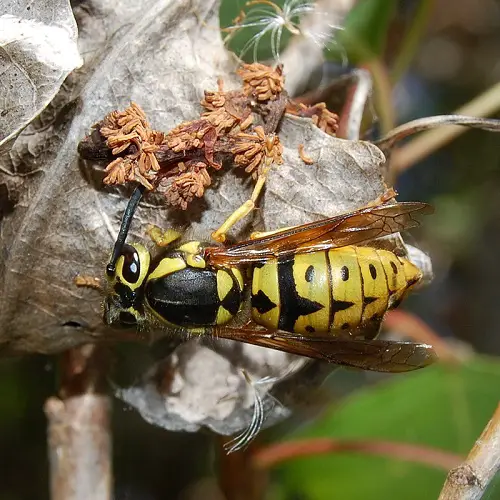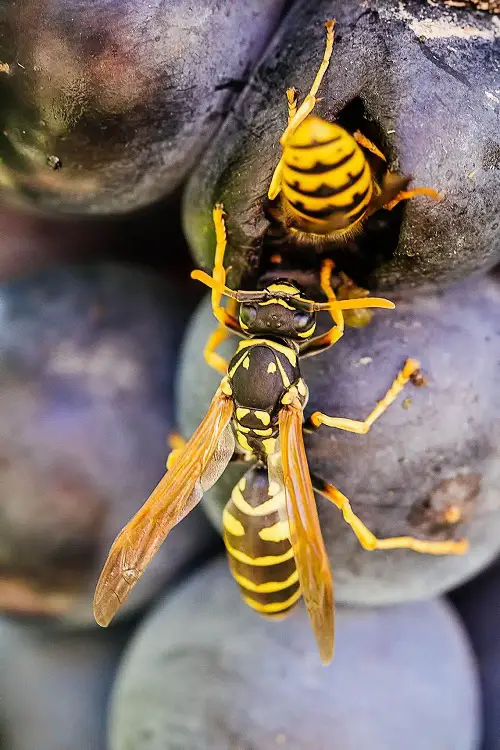Wasp vs Yellow Jacket – Don’t get stung by confusion! Explore the world of these buzzing insects and learn how to identify them easily!
You’re at a summer picnic, and you hear that unmistakable buzz. A black and yellow insect darts past you, and suddenly, you’re left wondering: is it a wasp or a yellow jacket? Well, we’ll clear the confusion!
What is a Wasp?
Wasps are part of the Hymenoptera order – most of which are flying insects with slender bodies that have yellow and black bodies, like bees and sawflies. But unlike bees, wasps are carnivorous and prey on other insects.
Wasps have both social and solitary behaviors. Some of these, like yellow jackets, are social ones that form a huge nest for a colony, whereas solitary wasps like mud daubers live and hunt alone. These can be considered pests because their sting is quite painful, but they’re essential for controlling the insect population in an area.
What is a Yellow Jacket?

Yellow jackets are a part of the Vespula genus. Vespula and its sister genus Dolichovespula are both a part of the Hymenoptera order. They’re social wasps and are often confused for bees because they also have yellow and black stripes on their bodies. However, they lack the hairy appearance and don’t pollinate plants as much as bees.
So, yellow jackets are a type of wasp.
Follow these DIY Wasp Trap Ideas for the Garden
Wasp vs Yellow Jacket – Differences

Physical Appearance
Wasps
- Color and Markings: Many wasps have a brown color with yellow or orange hints.
- Size: Wasps are generally larger and have 1 to 1.5-inch bodies.
- Body Shape: They have a slim, elongated body that narrows at the waist.
- Wings: Wasps have two pairs of wings that fold longitudinally when at rest.
Yellow Jackets
- Color and Markings: Yellow jackets are easily identified by their vivid yellow and black patterns (bands or stripes).
- Size: They’re smaller in size, only reaching 1/2 to 3/4 inches in length.
- Body Shape: Yellow jackets are not slim and have a more robust, stocky build.
- Wings: Their wings are usually spread out laterally when they are at rest.
Behavior and Social Structure
Wasps are less aggressive and don’t sting you unless they feel threatened. Their colonies are relatively small and have dozens to hundreds most of the time. There might be thousands as well in rare cases.
They are carnivorous, feeding on smaller insects, but sometimes consume fruits as well.
Yellow jackets are aggressive, especially when defending their nest. They also sting you multiple times. Their colonies are significantly larger, often housing hundreds of thousands of these insects.
They have a diverse diet, ranging from proteins to sugary foods.
Sting and Venom
Wasps can sting multiple times, as their stinger is not barbed. The venom is less potent but can cause allergic reactions in sensitive individuals.
Like wasps, yellow jackets can also deliver multiple stings as they have a non-barbed stinger as well. Their venom is more potent and poses a higher risk of severe allergic reactions. Do seek medical attention if you’re stung by one.
What Does it Mean When a Ladybug Lands on You?
Wasp vs Yellow Jacket – Similarities

1. Physical Features
Both wasps and yellow jackets possess a hard exoskeleton to protect their internal organs and have the head, thorax, and abdomen.
Wasps and yellow jackets have two pairs of wings, which allow them to be highly mobile and capable fliers.
2. Behavior Traits
Yellow jackets are social insects that form colonies, but there are many solitary wasps, too – like spider wasps and cicada killer wasps.
Both insects are capable of stinging when provoked or when you threaten their nests.
Wasps and yellow jackets are opportunistic feeders, and you’ll often find them foraging for food scraps.
What Does it Mean When You See a Firefly | Spiritual Meaning
3. Nesting Habits
Wasps and yellow jackets make nests of a paper-like material, which they create by chewing wood fibers and mixing them with their saliva.
4. Reproductive Behavior
Just like bees, there is a single reproductive queen that dominates the colony. She lays all the eggs and is usually the mother of all the other insects in the nest.
Both insects follow a seasonal life cycle, with new queens emerging in the spring to establish new colonies. They die off in the winter.
5. Ecological Role
Both wasps and yellow jackets play a role in controlling other insect populations by preying on smaller insects.



